February 3, 2019
The pig arrived on Sunday in the back of a van (well, actually it was a pig and a half).
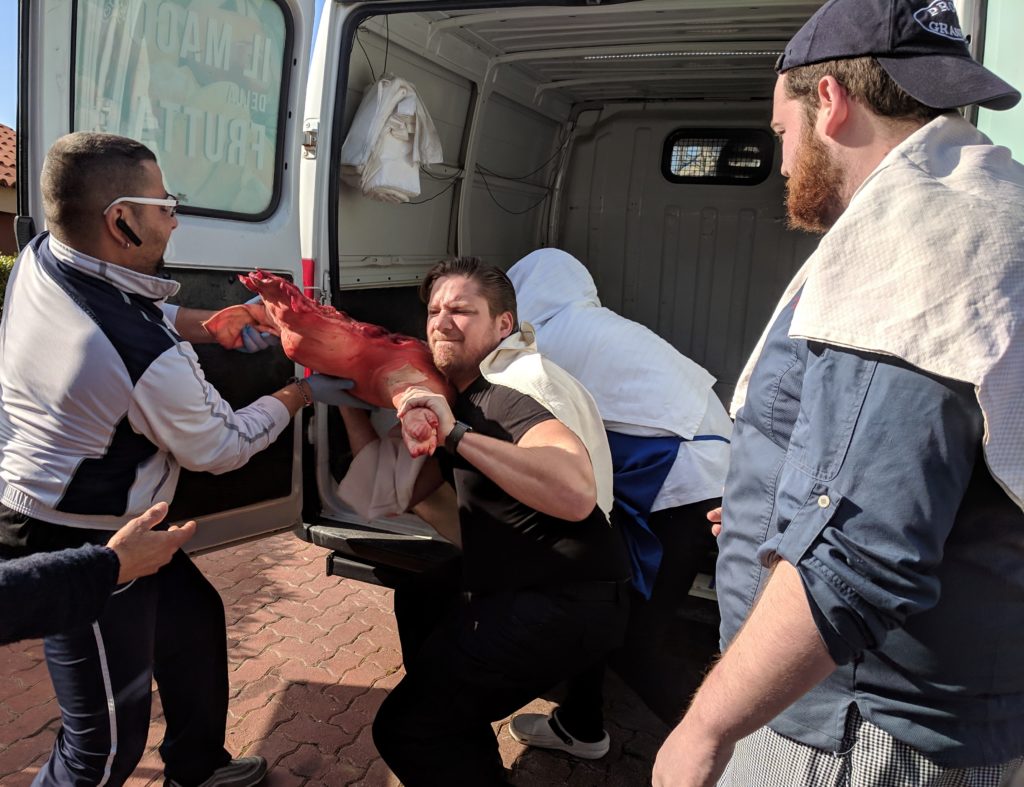
The pigs were raised by a local family that also has a restaurant. They were fed restaurant scraps (really good food) and finished with hazelnuts and chestnuts for the last three weeks or so. Hazelnuts and chestnuts are plentiful here.
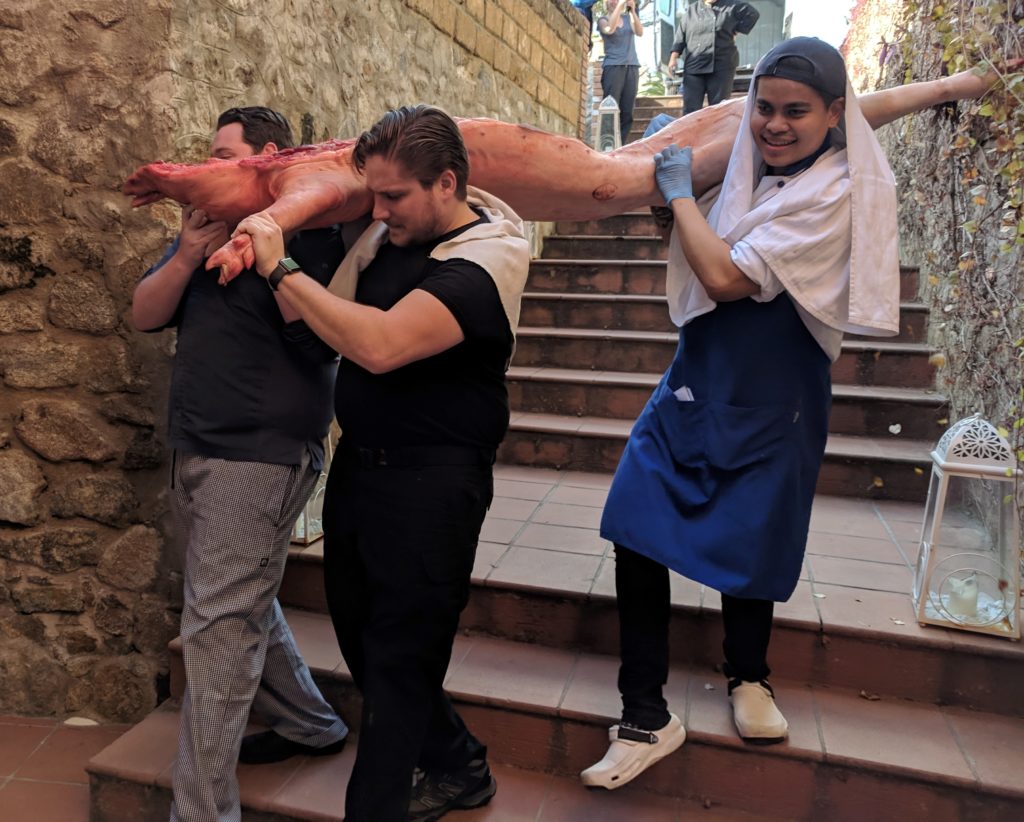
Each half-pig weighed about 165 pounds. Getting to the school from the nearest access point for a vehicle involves at least one staircase. Getting a 165-pound side of pig down a staircase is a group effort requiring strength and coordination.
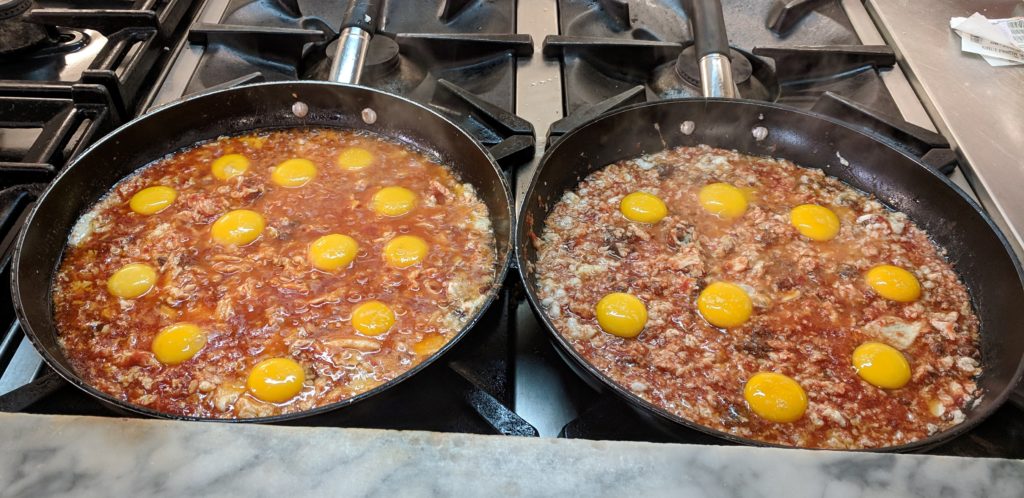
The pigs went into our walk-in cooler to await class on Monday.
In addition to the 13 of us who are on this three-month odyssey of Italian Regional Cuisine, we were joined by 5 additional students for Pig Week. We refer to them as the Pig People. Apparently, we will also be joined by Gelato People, Conserve People, and Cheese People for a week each, during the remaining 10 weeks. That leaves about seven weeks where it’s just the 13 of us. I don’t think we’re joined by any Alcohol People for our week of mixology and distilling.
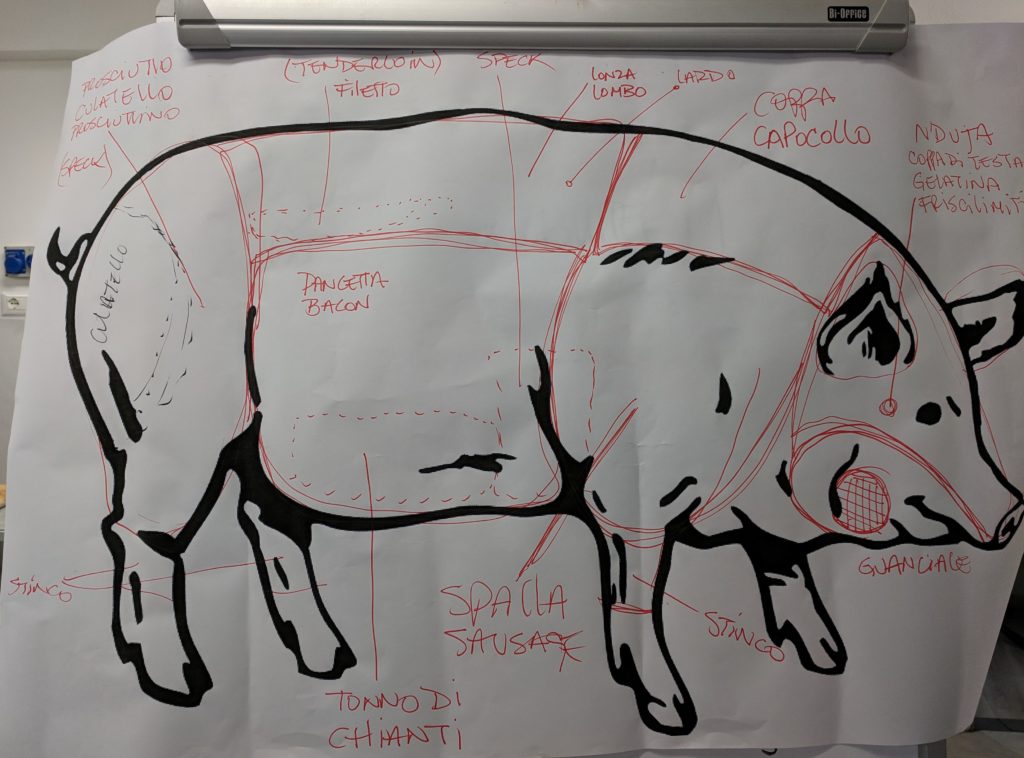
On Monday, January 28th, Chef John demonstrated how to butcher a pig into the primal cuts for processing into traditional Italian salumi (plus discussing a few variations on the cuts based on the objectives of the person doing the butchering). Afterwards the other two half-pigs were brought into the kitchen for us to butcher. I have three pages of (sometimes cryptic) notes on how Chef butchered the pig.
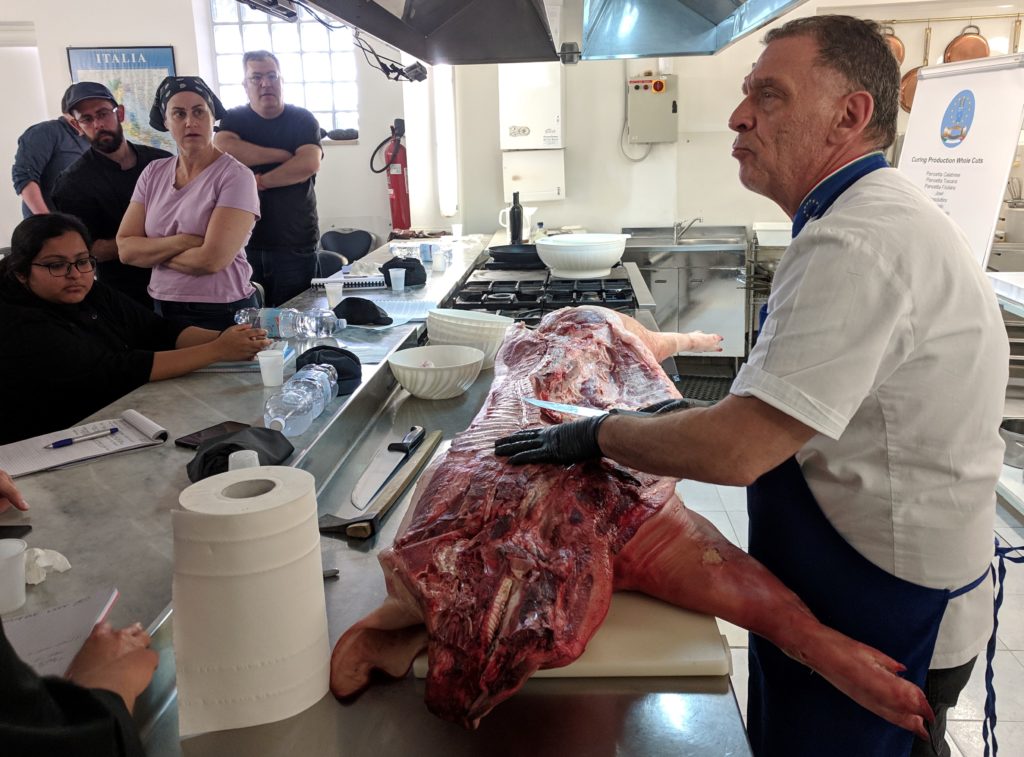
But first, of course, we had to taste. We tasted at least seven different cured meats, all but one of them made at the school.
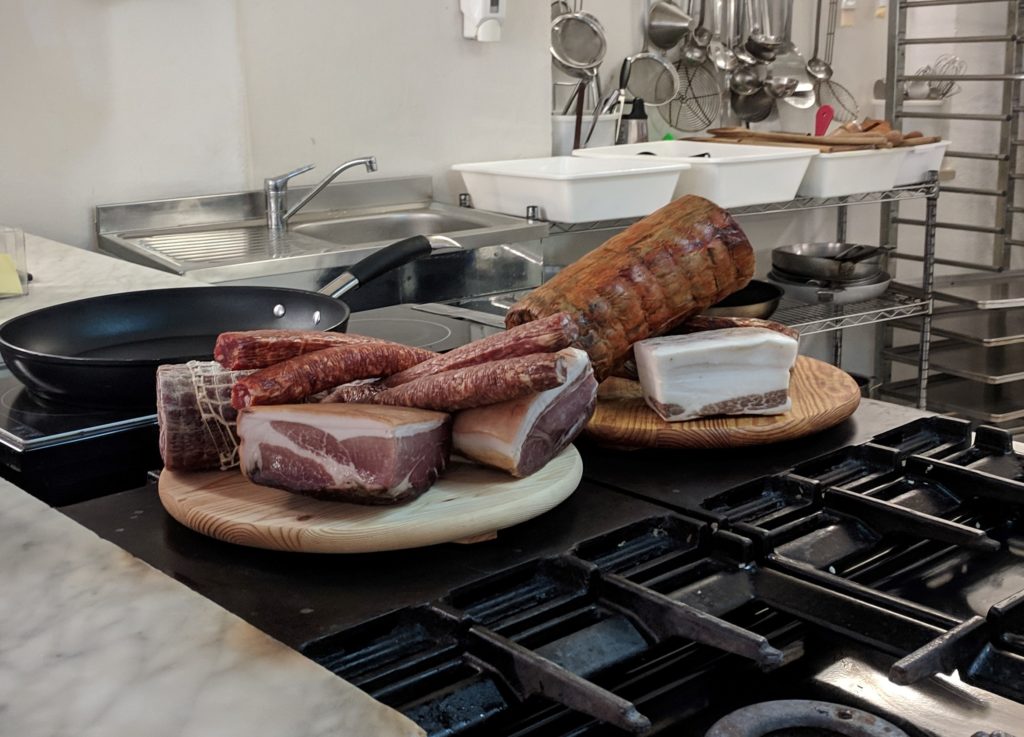
After being butchered into primal cuts, several large cuts were salted as part of the initial cure. These included:
- Pancetta Rotolo (rolled pancetta)
- Pancetta Tesa (flat pancetta)
- (American) Bacon
- Capocollo
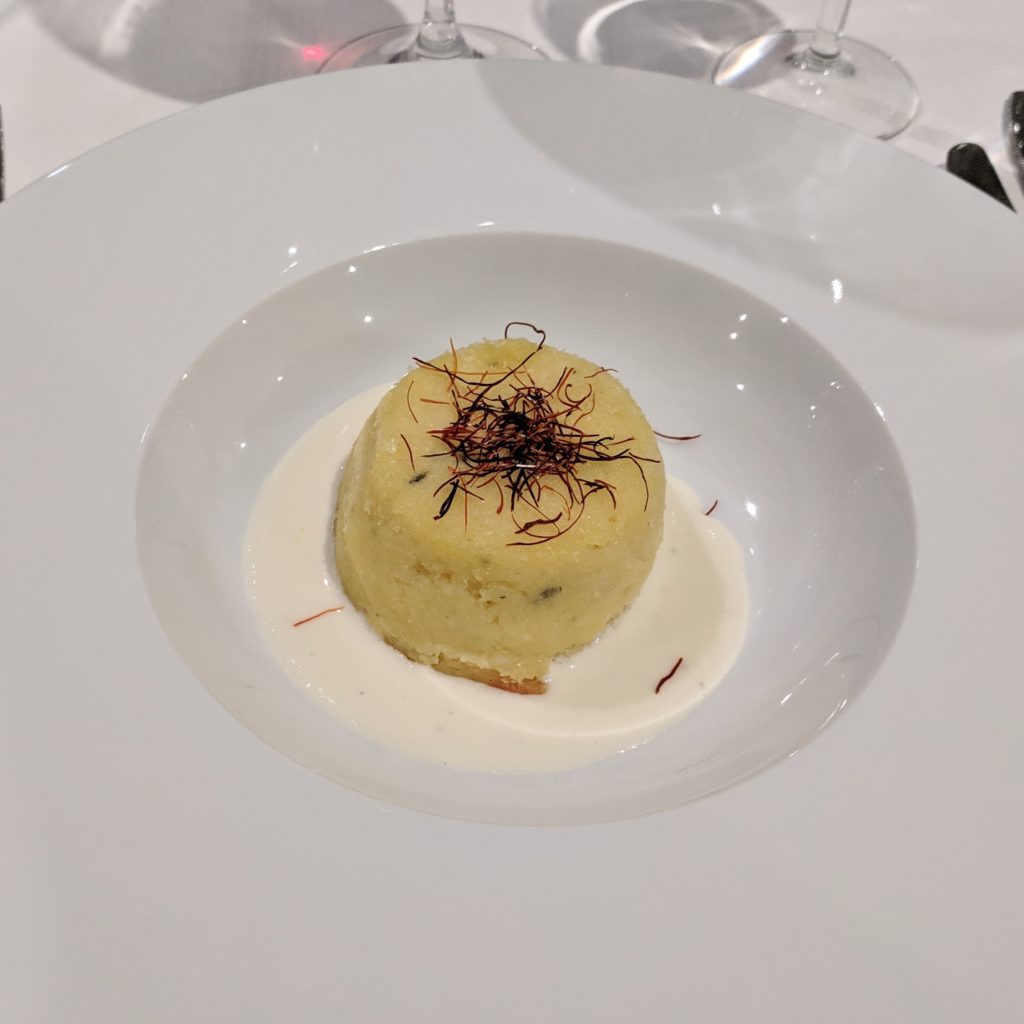
Chef wanted to completely disinfect the kitchen so we didn’t prepare dinner that evening. Instead we went to La Tavernetta, the restaurant in the hotel on the same property as the school, for dinner. It was a special event with one table full of local chefs and us at another table. The meal was intended to highlight three versions of a local stewed trip dish, Morzello di Catanzaro, each flavored with a different hot pepper. The first course, was an ‘nduja-stuffed potato puree on top of caciocavallo fonduta. Then came three courses of stewed trip served inside of bread. After the second, Mariana asked that we just get the stew, minus the bread, for the third round as the bread was not getting eaten (much of the tripe was not getting eaten either but that’s a different matter). The meal finished with pistachio gelato on crème anglaise, topped with melted chocolate.
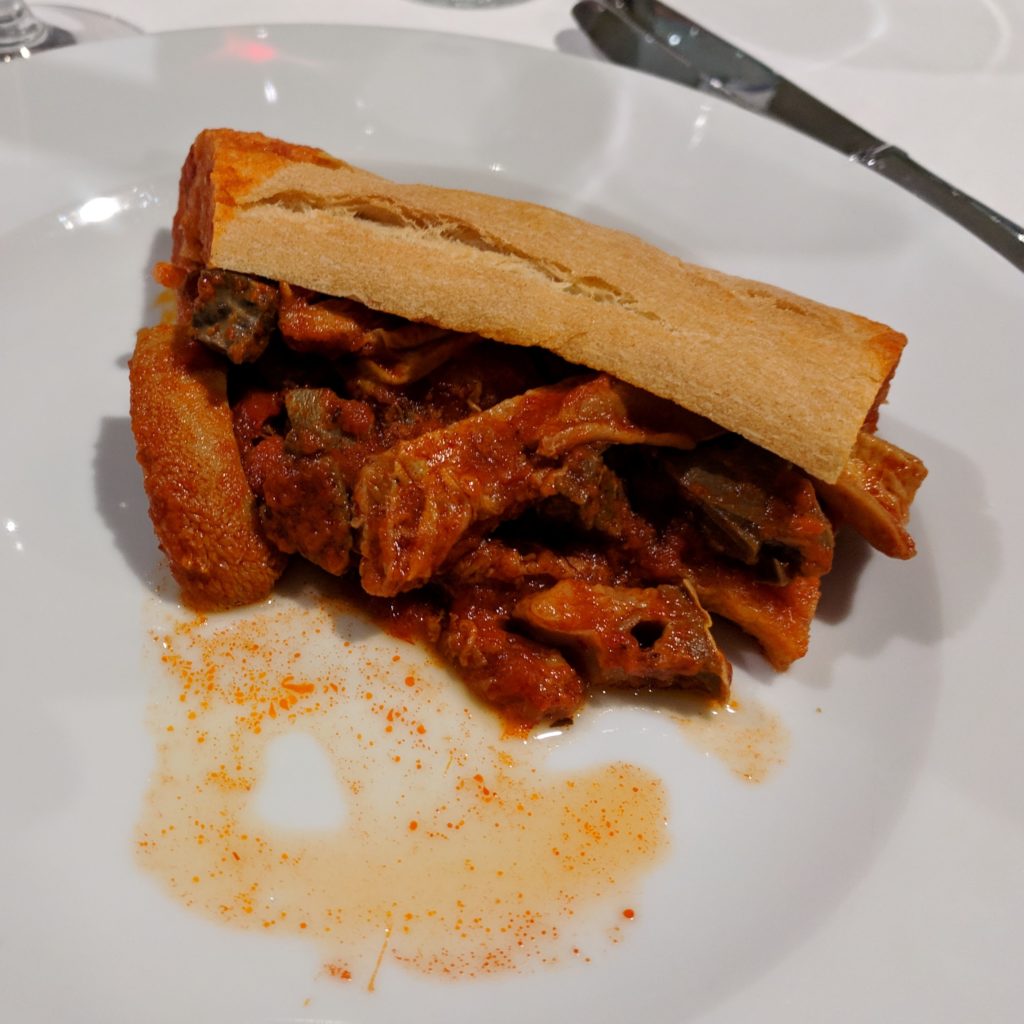
On Tuesday, we continued with making:
- Franken-Fileto [see below]
- Guanciale (cured pork jowl)
- Porchetta [see below]
- Pickled Pork (like corned beef but made with pork)
- Lardo (a yummy slab of cured pork fat—similar to salt pork but better—not to be confused with rendered “lard” which is called strutto in Italian)
- Prosciuttino (similar to prosciutto but smaller as the weather in Calabria is not conducive to curing an entire ham)
- Speck
- Tonno del Chianti
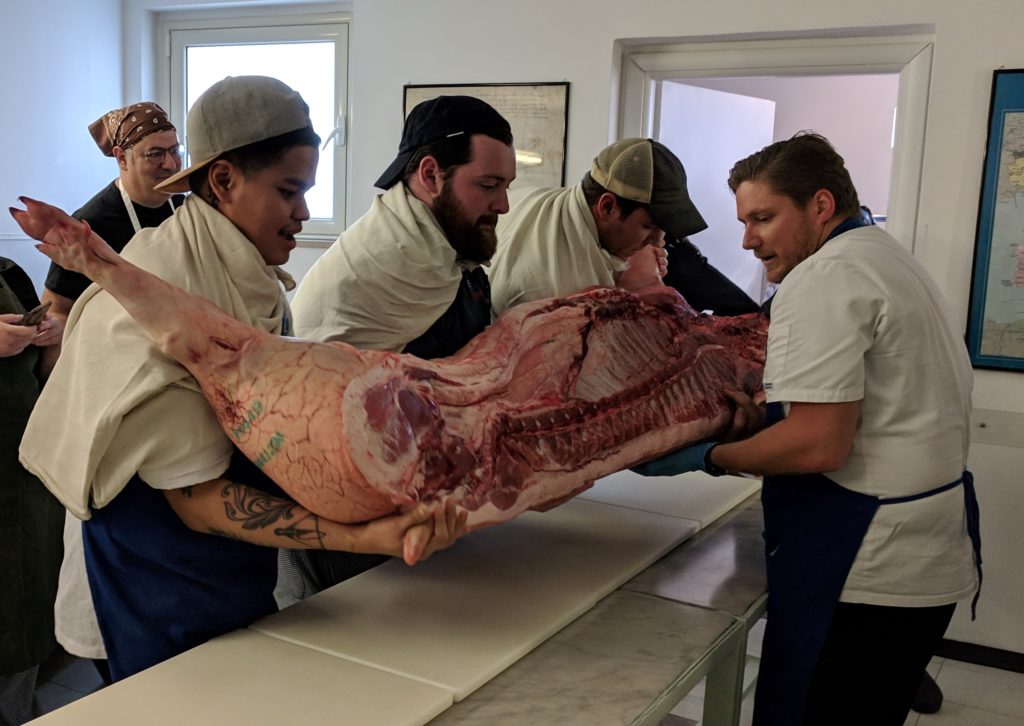
Butchering a pig for Italian Artisan Salumi (salumi is the Italian word that is equivalent to the French word charcuterie) creates a whole new perspective. In the States, cuts like the loin and tenderloin are among the most expensive. When purchasing a whole pig, every part of the pig costs as much as every other. The most valuable cuts for curing are not the loin and tenderloin because they are too lean. Much of those cuts ended up being made into sausage!
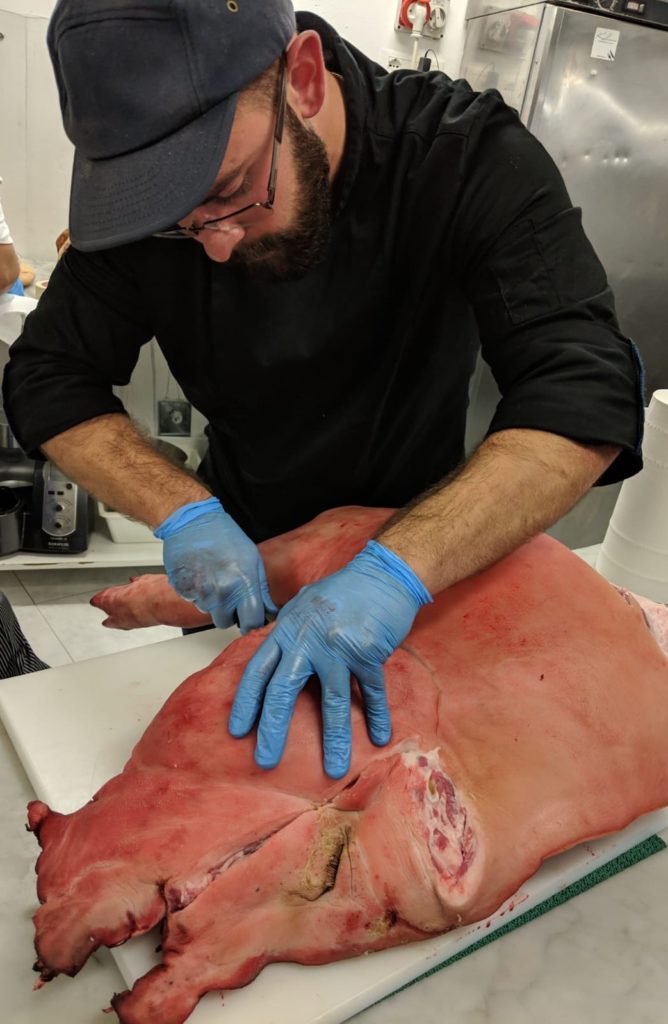
One of the tenderloins was turned into a Frankenstein version of a cured meat (Franken-Fileto). The loin was carefully butterflied and topped with a layer of fatback that was pounded thin. The combination, about 80% tenderloin and 20% fat, was salted for curing, tightly rolled in plastic wrap for shape, and hung in the refrigerator for 48 hours before being, unwrapped, tied and hung in the hanging room.
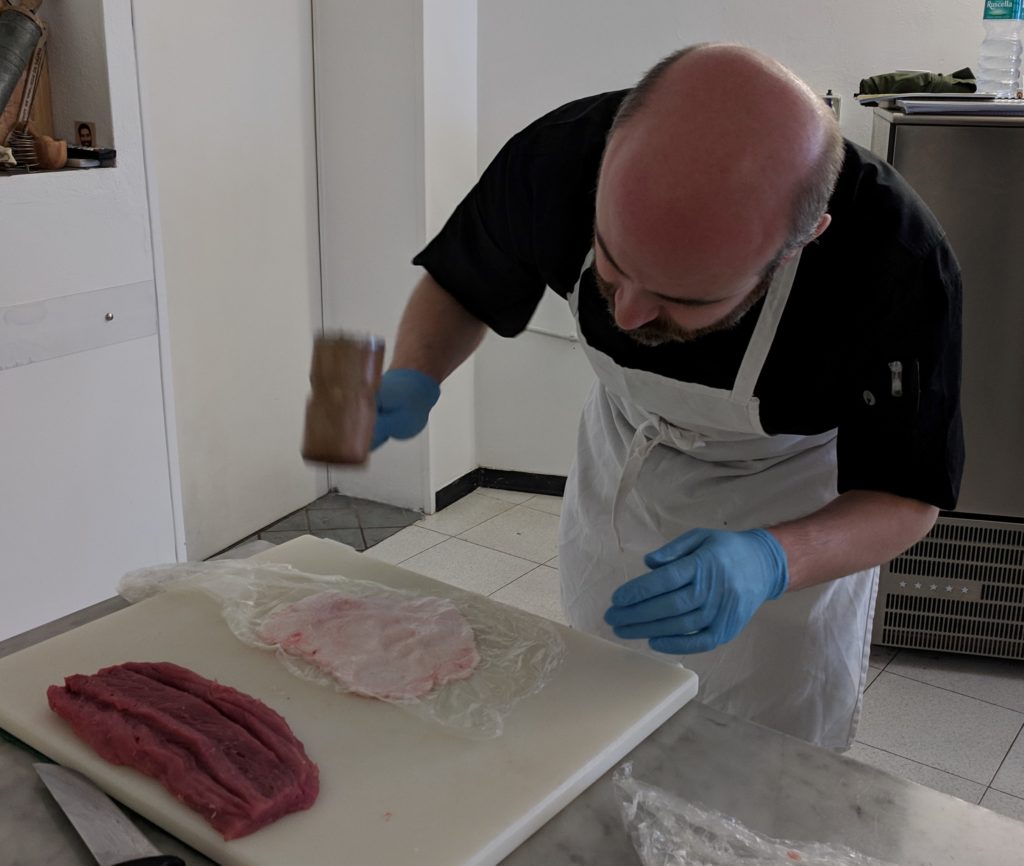
Traditional Porchetta is made from a whole suckling pig with the bones removed. Porchetta-style roasts abound in Italy. The one we made consisted of a slab of pork belly (the cut from which bacon and pancetta are made) rolled around the loin, tied, and roasted for hours. Traditional seasonings include garlic, rosemary and fennel. Chef opted to slater the meat, before rolling, with a massive quantity of pureed truffles. [We have consumed an obscene quantity of fresh truffles since starting this course.] The Porchetta went into the fridge to be pulled out for dinner on Wednesday.
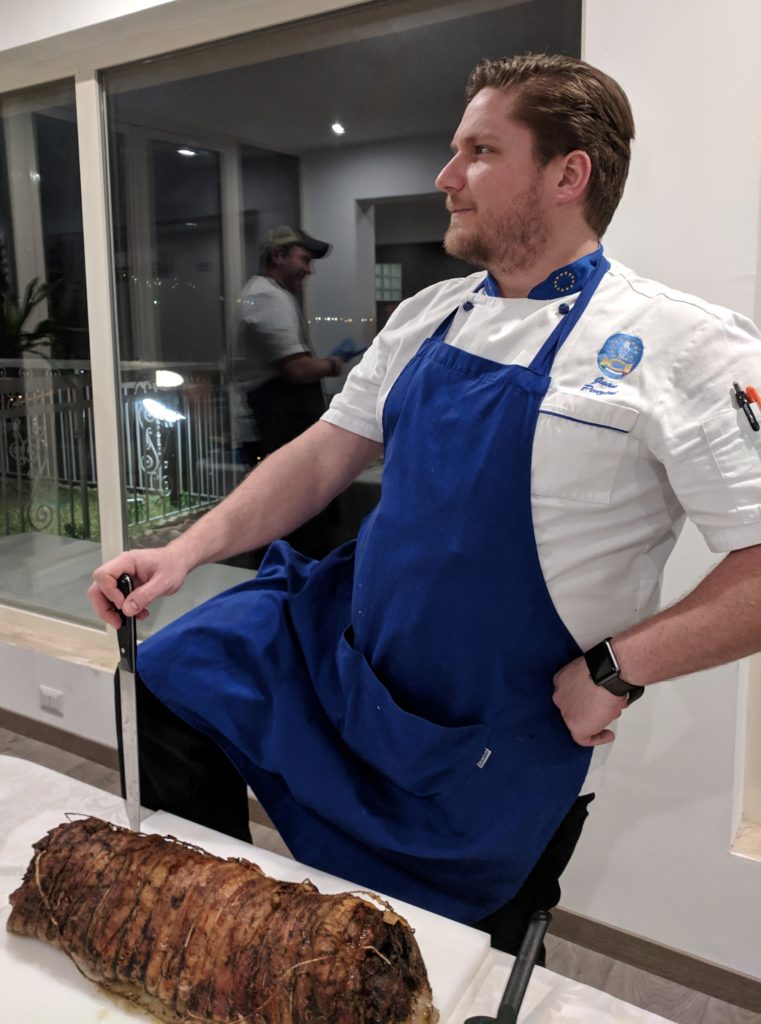
Chef got creative and demonstrated the production of Rabbit Porchetta using 20 rabbit bellies and rabbit fat (remember the rabbits we butchered with stone knives?). The Rabbit-chetta was cooked sous vide, then chilled, smoked, and brushed with maple syrup (OK, so it’s not Italian but it was good!) He also made a Lamb-chetta from four lamb bellies that ended up being served as a snack of Lamb and Eggs a few days later.
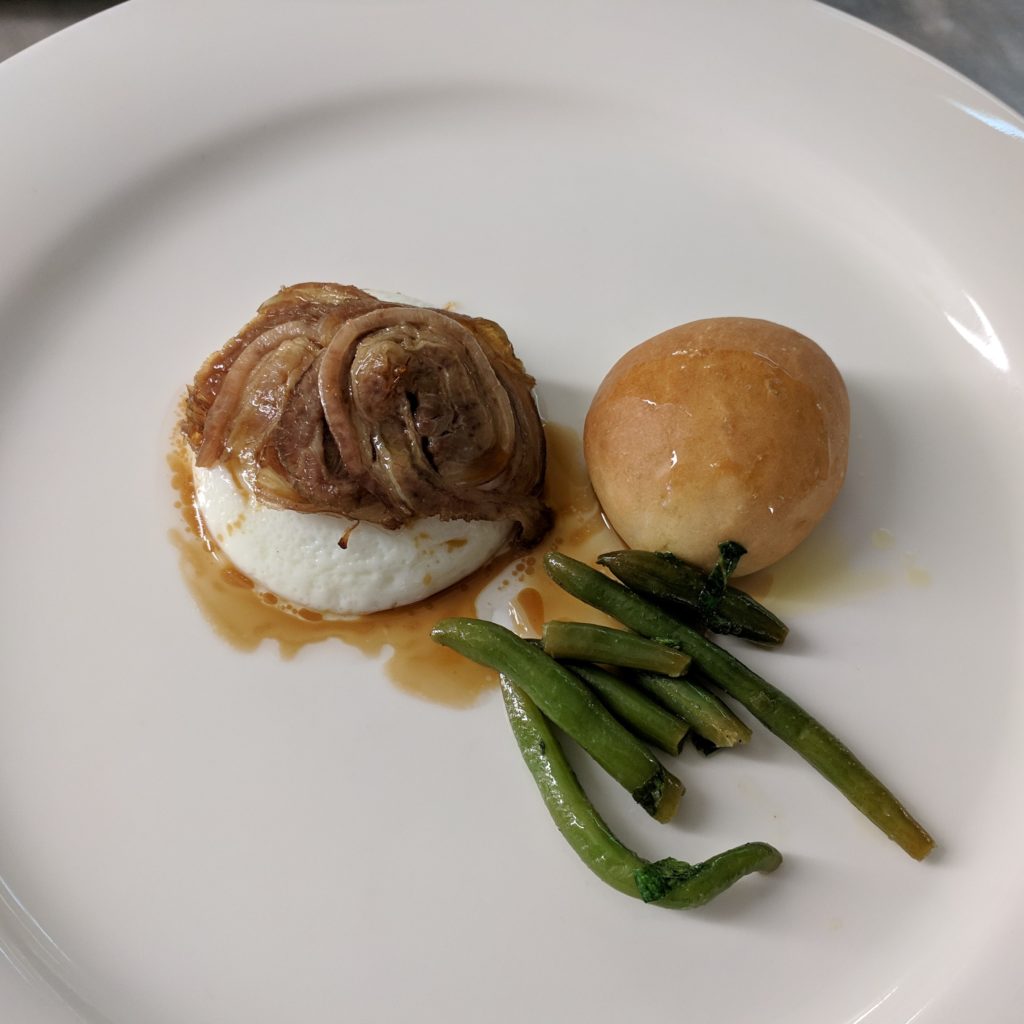
Dinner was at a local pizzeria as the kitchen, once again, needed to be sanitized.
Wednesday started with a lecture on the science of meat curing by Chef Juan. Other than herbs and spices for flavoring, the only product used at the school to cure meat is salt. Absolutely no nitrates or nitrites are added.
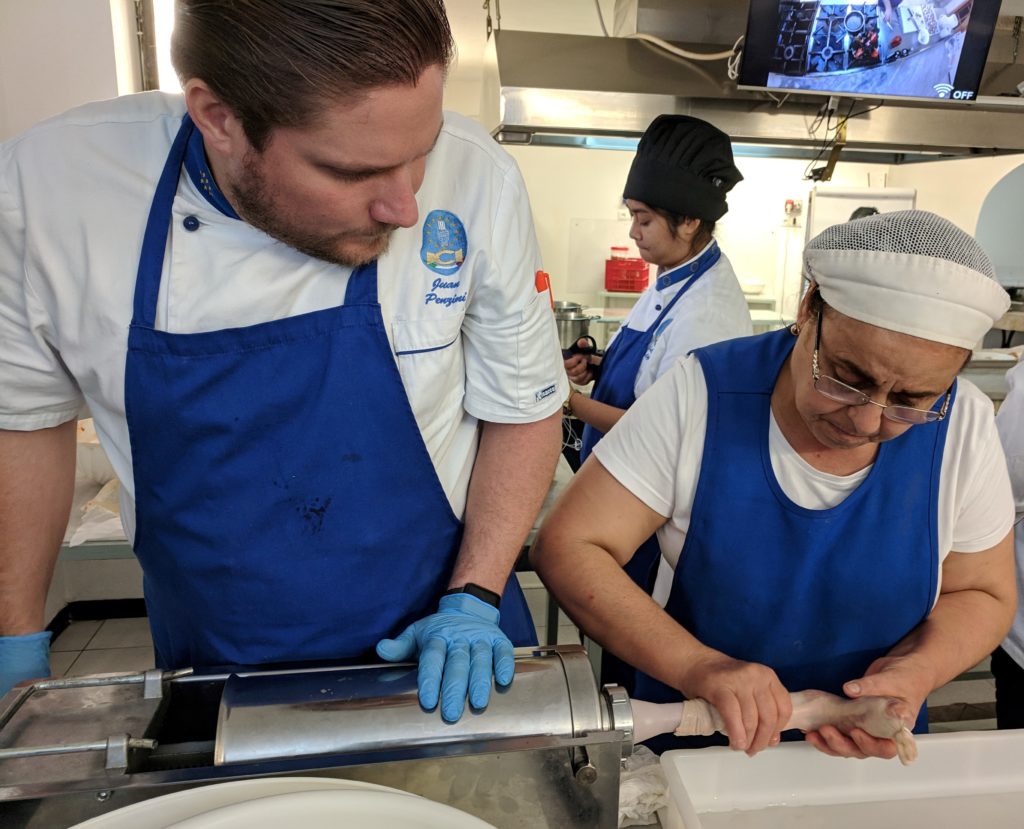
The previous days as we were butchering the pigs, anything not destined for a specific purpose was put into one of two piles labelled Bollito #1 and Bollito #2. Bollito simply means boiled. Bollito #1 contained bones (like ribs) with some meat attached. Bollito #2 contained all the other bits and pieces (specks of meat, gristle, silver skin, fat that wasn’t good for sausage making, etc.). These were all soaked for a day in cold water in the fridge and then boiled…and boiled…and boiled. The head and ears were also boiled.
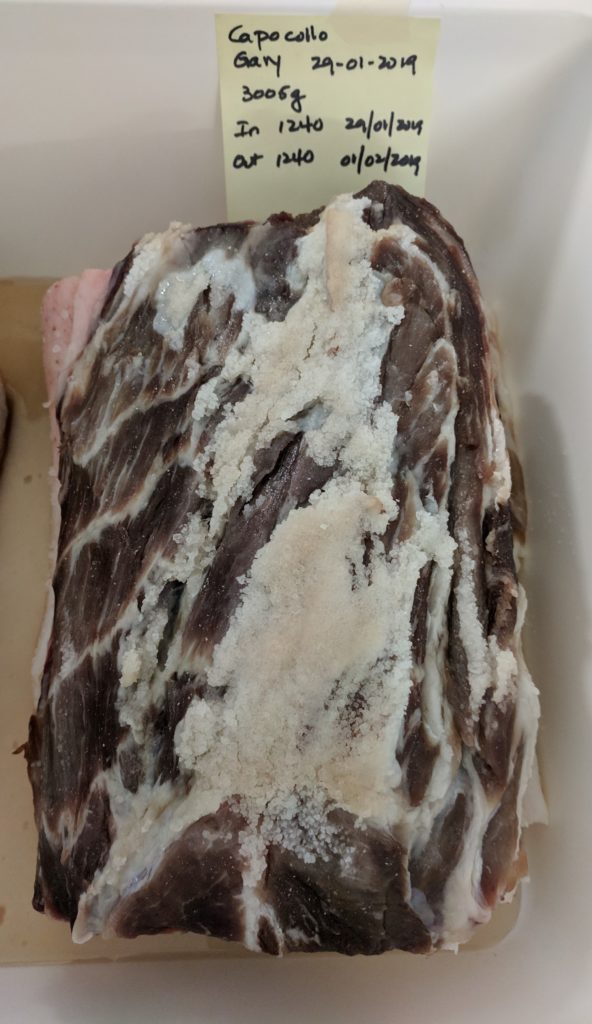
Bones with meat attached (like ribs), from Bollito #1, were served with some broth, salsa verde, and bread as a snack! The fat skimmed off the top of all the bollito pots was turned into strutto (lard). Bits of meat from the head were turned into ‘nduja or coppa di testa (head cheese). Any remaining bits became frischilimiti. The broth was concentrated to make gelatin.
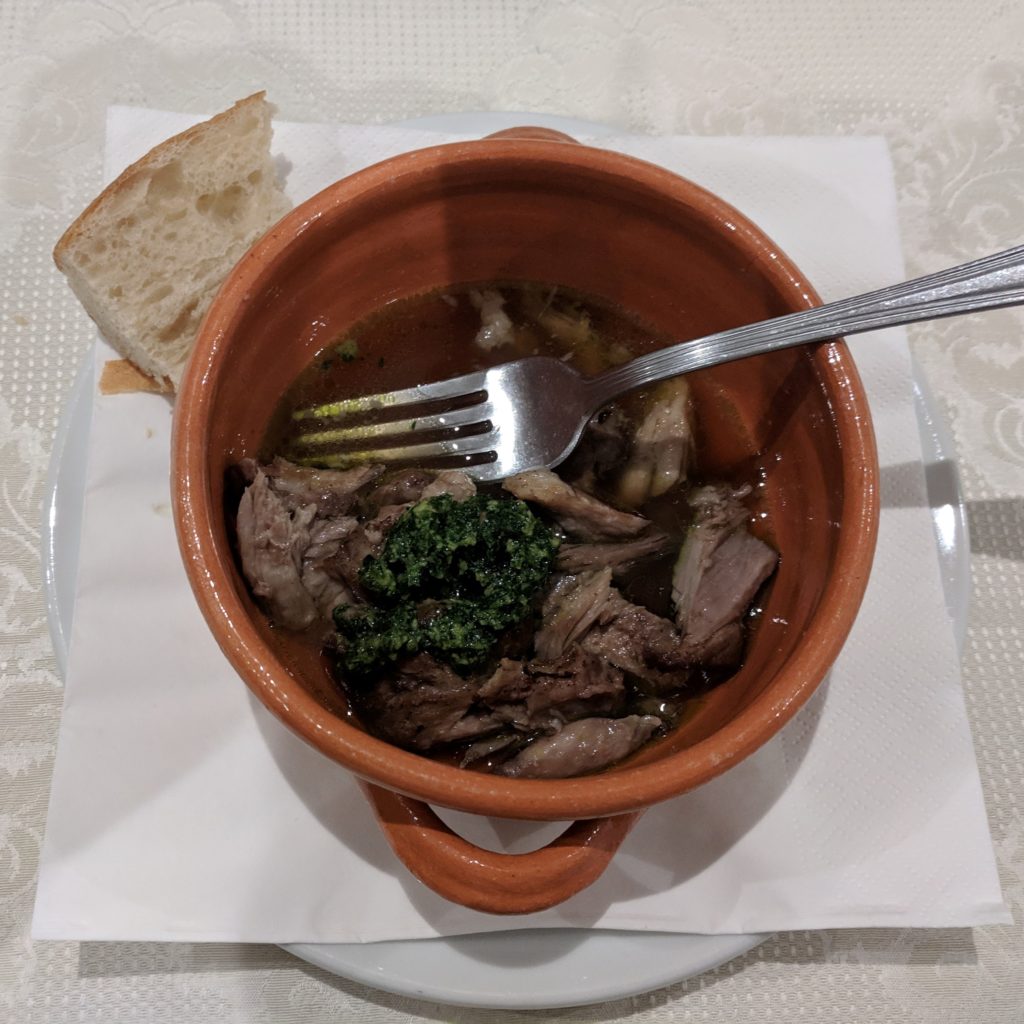
Frischilimiti (all those tiny bits of cooked pork) were crisped in a sauté pan with lard (of course, being pig week), eggs were nestled on top and when appropriately cooked, served as a morning snack with cotechino and bread.
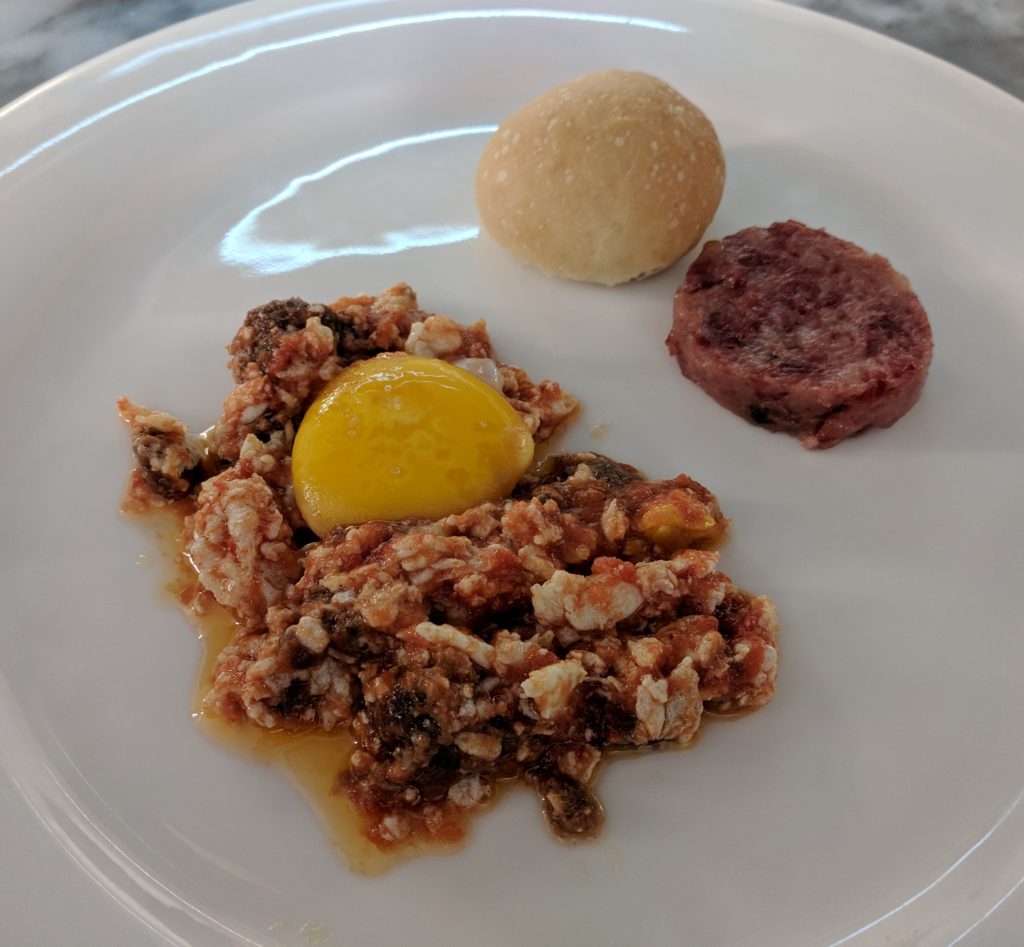
The rest of Wednesday was devoted to seasoning batches of meat for our cured salami and fresh sausage. The cured salami included:
- Salsiccia (which is cured and not served fresh)
- Sopressata
- Salame Napoli
- Salame Brianza
- Salame Gentile
- Ciauscolo
- Salame Milano
- Salame Fabriano
- Salame Felino
- Strolghino
- Lucanica
- Salame di Mugnano
- Tartufo
- Cotechino
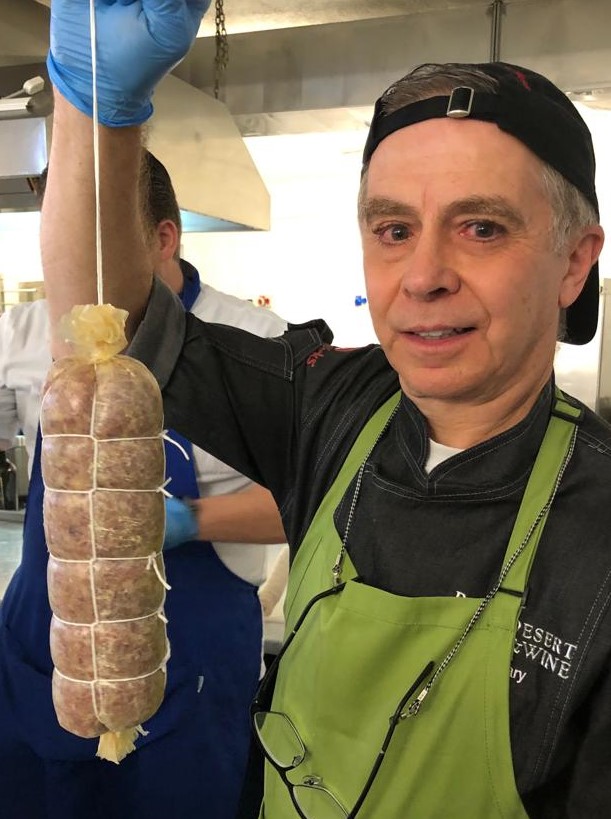
After those were made, the 18 of us were set free to each make a fresh sausage of our choosing. Mine was 75% lean pork and 25% fat, seasoned with hot red Calabrian pepper, sweet red Calabrian pepper, coarsely ground black pepper, fennel seed, garlic, and red wine.
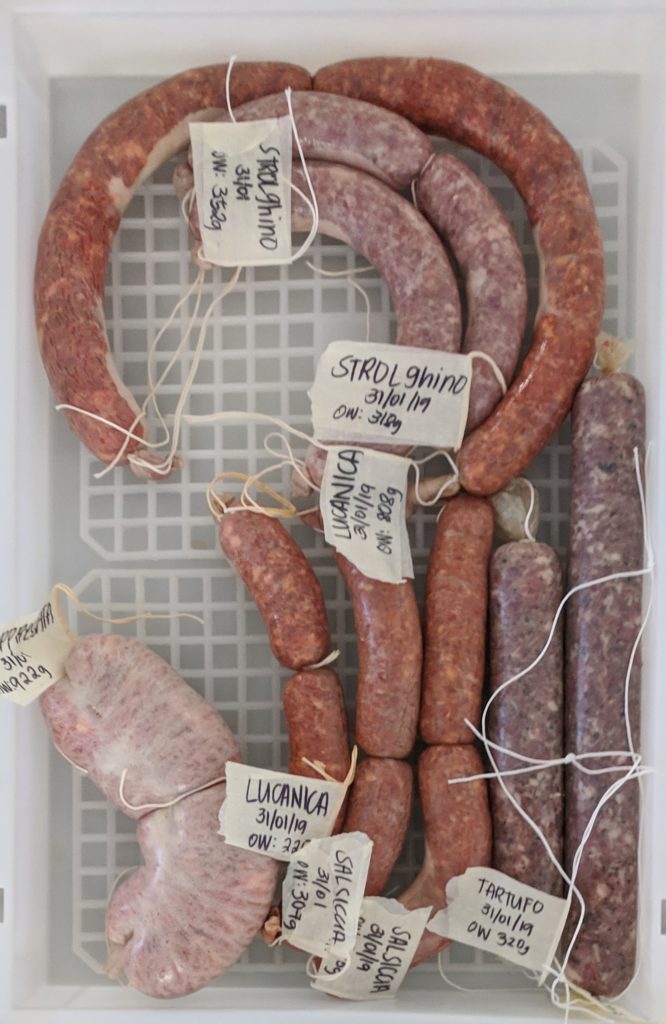
Making salami is serious business. There is no approximating the proportion of fat and lean. When butchering we separated completely the meat and fat. These were then recombined in specific proportions based on the requirements of each recipe.
Thursday started off with Chef continuing the bacon that had been salted three days earlier. The salt and sweet mixture (different for each) was washed off with some sort of alcohol. The one cured with salt and brown sugar was washed in Jack Daniels, smoked over chestnut wood, then glazed with maple syrup. The salt and white sugar one was rinsed with Amaretto, smoked over pistachio shells, and glazed with a concentrated coffee syrup. The salt and honey cured one was rinsed in brandy, smoked over chestnut wood, and glazed with honey. Each was put in the fridge where they would stay, uncovered, for about a week to allow the glaze to crystallize. At that point they could be used or vacuum packed and kept in the fridge for up to six months.
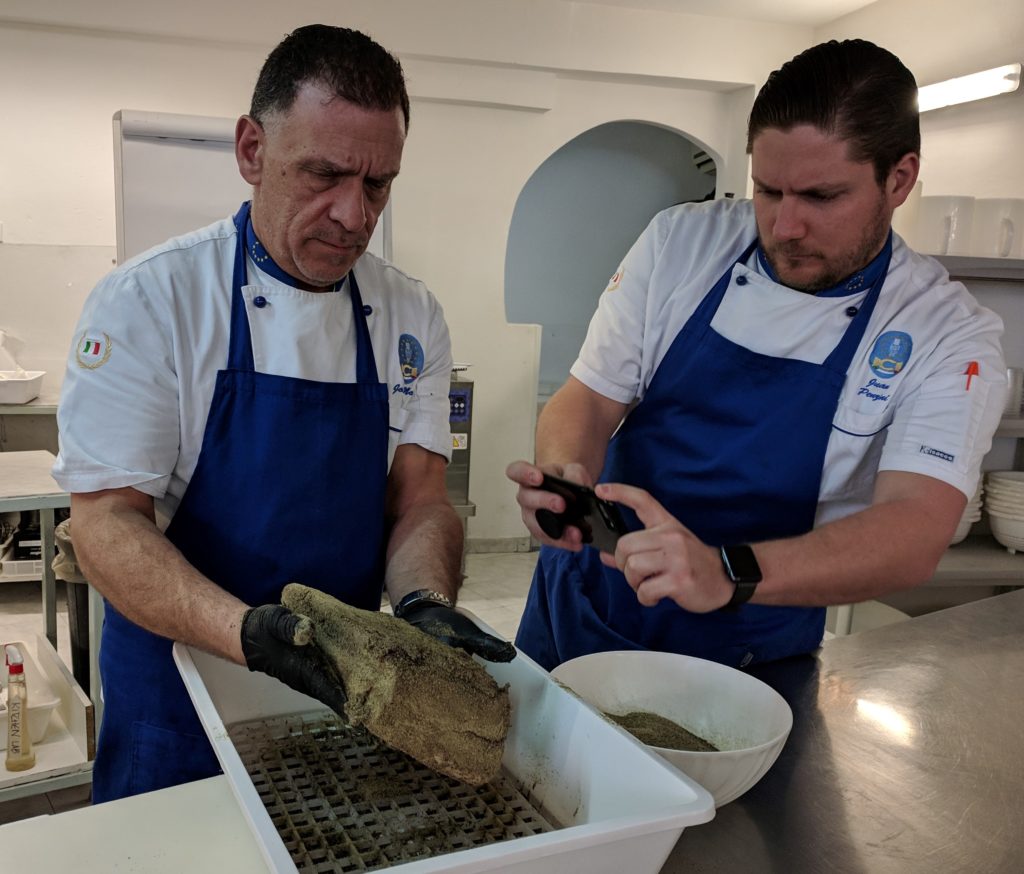
The speck was rinsed in grappa, coated with finely ground black pepper, smoked, then put in netting to be hung and aged before use.
On the spur of the moment, mid-morning, Chef took some of the concentrated liquid from Bollito #2, mixed it with orange-zest-infused 97.5% alcohol and some sugar, to make “Jello” shots. These went in the fridge and appeared at dinner on Saturday.
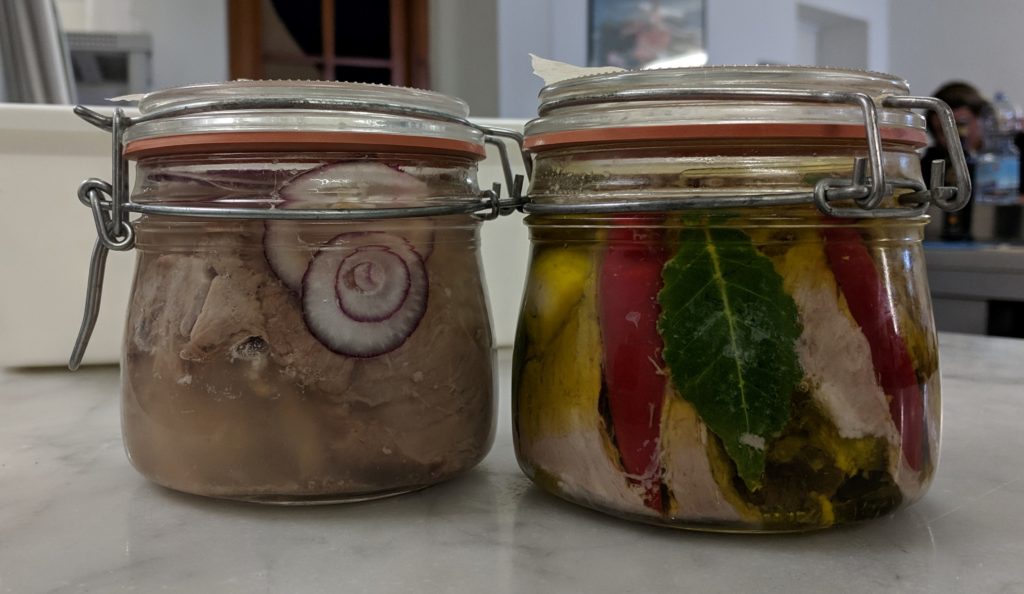
Chef then made Tonno del Chianti which means Tuna from Chianti. It is a well-known and beloved pork product that resembles oil-packed tuna. When butchering the pigs, we carefully removed the flap meat. This was boiled in a mixture of half vinegar and half water abundantly flavored with onions and bay leaves until fork tender then cooled in the cooking liquid. It was packed into jars with seasonings and either covered with extra-virgin olive oil or the cooking liquid and processed in a boiling water bath. We tasted some Tonno del Chianti from the previous production. I am most definitely making this stuff!!!
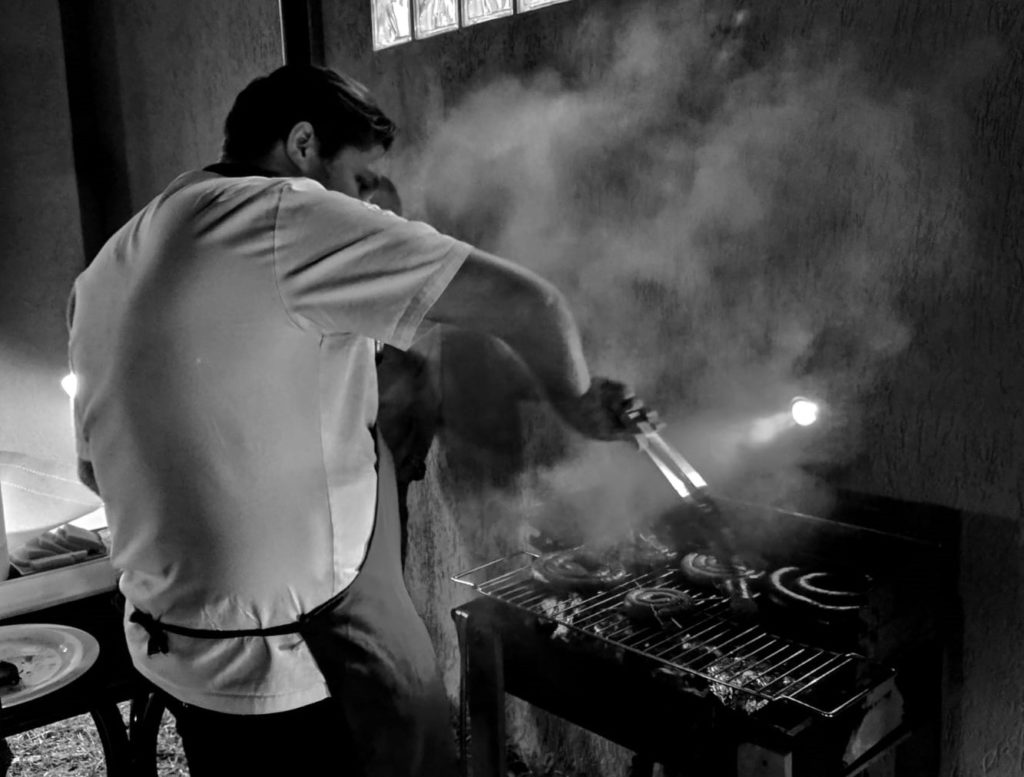
The rest of the day was spent stuffing all the salami and our personal sausages. The ground pork that was left after each of us took our portion for sausage the previous day had been seasoned for soppressata; nearly 20 pounds of it! A few of us assisted Maria, one of the dishwashers, stuff it into large intestine, as is traditional. Although Maria’s job is to wash everything and keep the kitchen tidy, she is an expert at curing meat. A warm, caring and wonderful person she feels like a grandmother though she’s a decade younger than I am. Apparently, she and her sister kill, butcher, and cure four pigs every year—all within about a week! I cannot imagine how they do this. It took four days for 18 of us, not counting staff, to do a pig and a half.
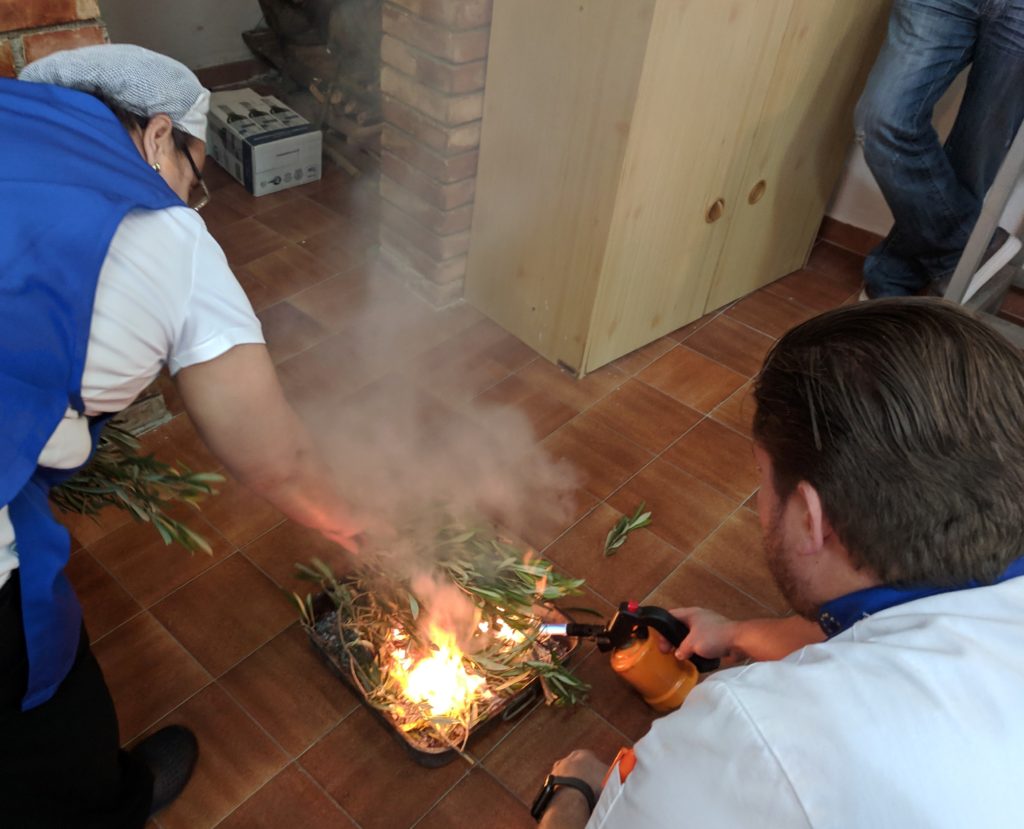
We went to the hanging room to hang the meats that were ready. Some need to be kept under refrigeration or cured at a warmer temperature before hanging. Cured meats are given a light smoking two or three times a day for the first four days, or so, after hanging. They do not taste smoky but the smoke acts as another preservative.
Friday morning we went to the mercatino. Friday afternoon saw the production of Coppa di Testa (head cheese) and ‘Nduja. We tasted several different versions of head cheese made a few weeks earlier, all were very good and quite different from anything I’ve had in the States. The best thing made with all the “bits” was ‘nduja. ‘Nduja is a spicy, spreadable salame. Chef’s version is approximately 1/3 cooked meat (mostly from the head), 1/3 raw fatback, and 1/3 Calabrian red chile (both a “paste” that resembles tomato paste as well as dried in powdered form). Everything is stuffed into a casing and hung to age.
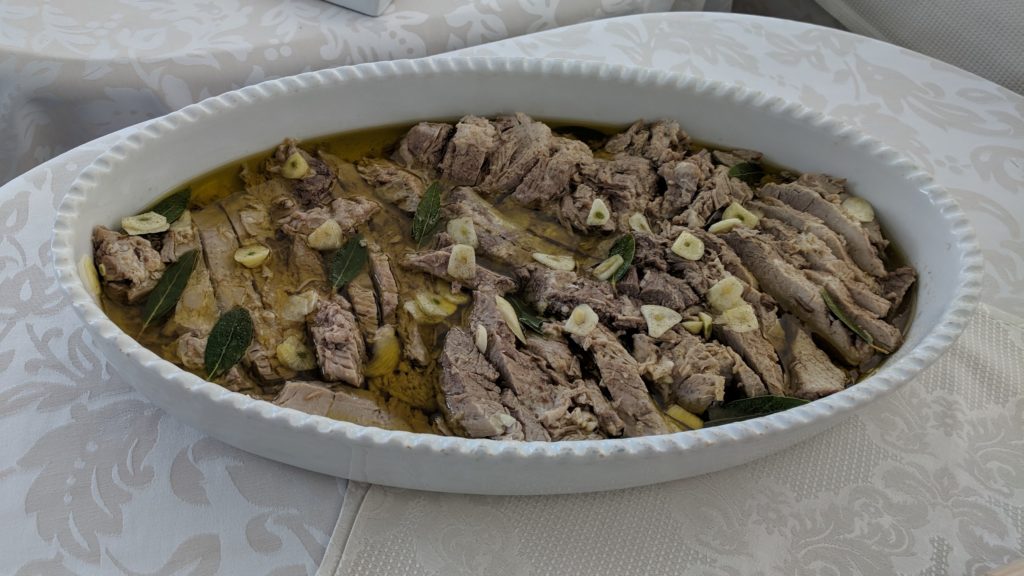
Chef Juan made blood sausage and bratwurst. Neither was particularly Italian, though Italians do make blood sausages. Both were great. The blood sausage was revelatory! With the main part of class over for the day, several of us stuck around to complete “maintenance” of salumi that had been started earlier in the week.
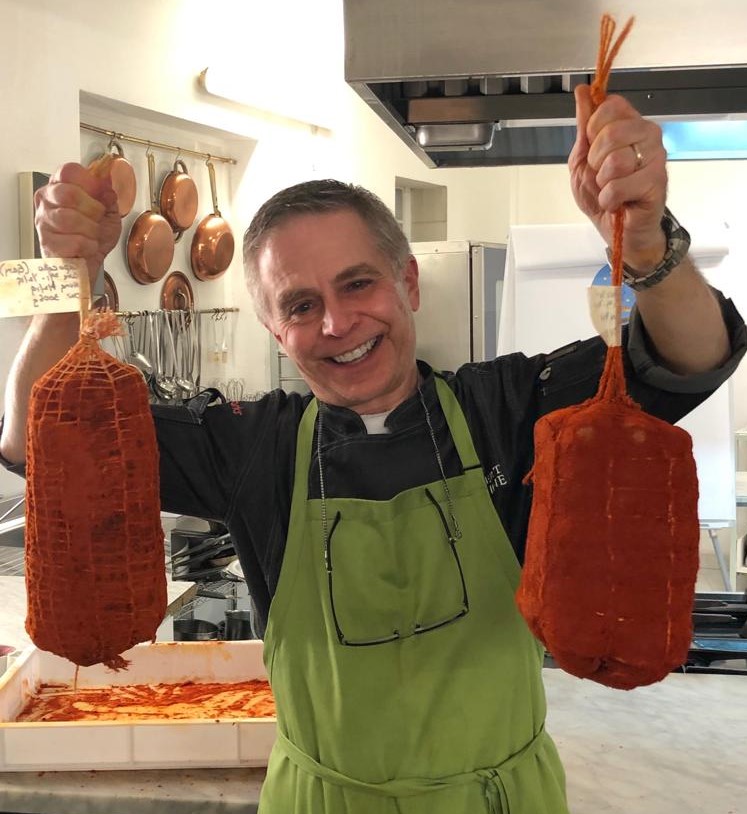
That evening dinner consisted of all fresh the sausages that we had made, expertly grilled by Chef Juan, and an array of accompaniments.
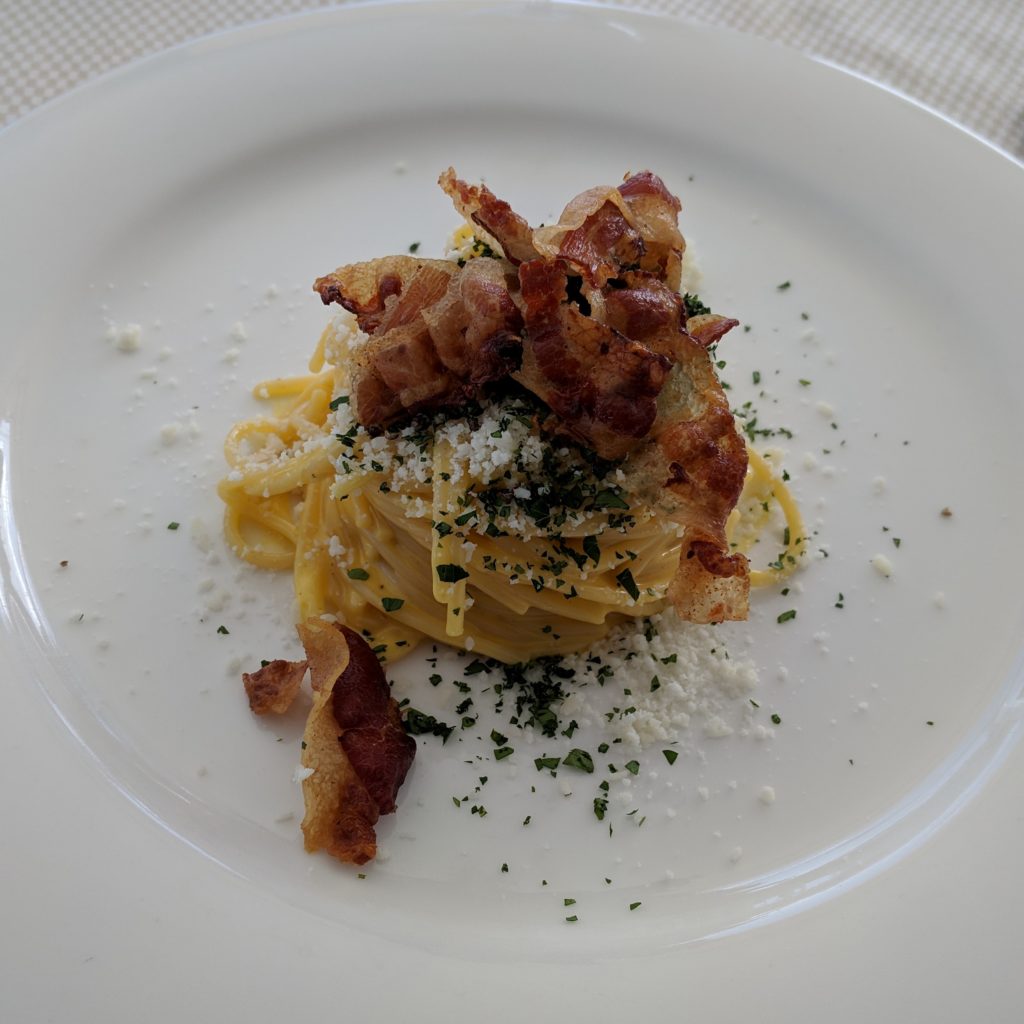
With Pig Week over, Menu Planning and Execution, our next adventure, was scheduled to start on Saturday at 11 AM.

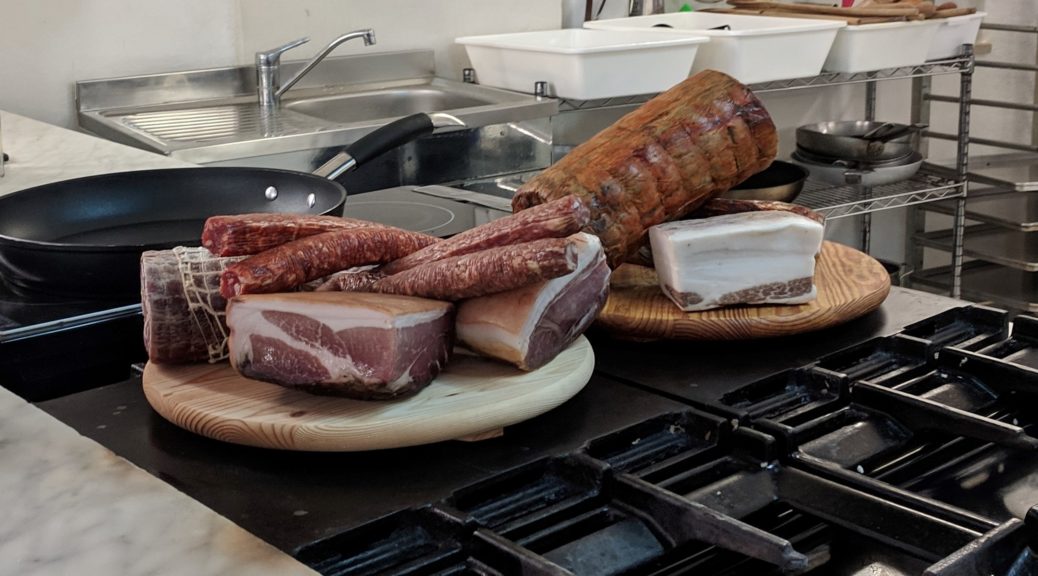
Am so enjoying following your adventures while at the cooking school. Learning so much.
I’m glad you’re enjoying reading. I was concerned that folks might not like the stories but I can’t really post recipes from here. I feel like I am learning a tremendous amount.
I’am glad “pig week “ is over! I guess you had to be there to taste the final product but the “process “ was painful 🙀! Looking forward to alcohol week👍
The cured pork products made at the school are amazing. No curing agents other than salt are used. I understand that Alcohol Week is a lot of fun!
I am always hungry after reading your posts! The Frischilimiti sounds lot like scrapple, and I guess many countries have some similar ways of using the last bits of the pig. Wondering what truffles cost there as consuming so many would cost a fortune in the U.S.!
Frischilimiti is definitely the Italian way to use the scraps that would get turned into scrapple in Pennsylvania Dutch Country but, and I like scrapple, the taste is so much better. The little bits are fried in lard. What’s not to like? Truffles are not cheap here but the school really wants us to experience the tastes of Italy. We have to plan and execute a multi-course lunch and dinner on Thursday. My group has lunch and we’re getting truffles, bottarga and caviar for our dishes!
Wow, what a ton of work! It is amazing how every single part of the pig is used, processed, re-purposed… Fascinating Gary. Thank you for sharing. I’m exhausted and full just reading!
Every part gets used. In fact, the intestines that were left after we stuffed everything that needed to be stuffed were chopped up and cooked with green lentils. The dish was amazingly good.
Not only are the detailed descriptions of the process engaging to read, but the photographs are terrific, too! So glad you get to have this experience of a lifetime, Gary!
Thanks, Rick! Most of the photos actually end up being shot with my phone as that is the most accessible device in the kitchen. I’m glad they seem to be (generally) turning out OK.